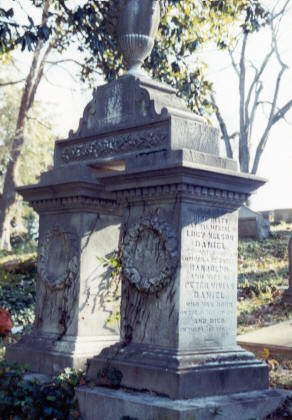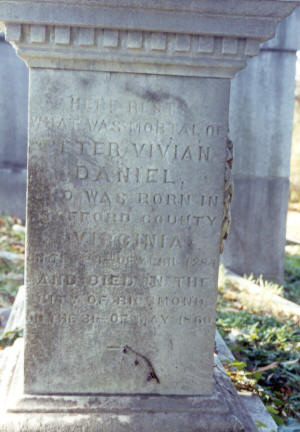Peter Vivian Daniel (Peter Vivian Daniel)

Daniel was born in Stafford County, Virginia, in 1784 to a family of old colonial heritage. He was educated at home, and attended the College of New Jersey for one year before returning to Virginia. He read law under former Attorney General of the United States Edmund Randolph in Richmond, and was admitted to the bar in 1808. Daniel married Randolph’s daughter. In 1809, Daniel was elected to the Virginia House of Delegates, and in 1812 became a member of the advisory Virginia Privy Council. He remained on the Council and in 1818 was elected Lieutenant Governor of Virginia. He would retain both of these positions until 1836, when President Andrew Jackson appointed him to the federal judiciary. On April 6, 1836, Daniel was nominated by President Jackson to a seat on the United States District Court for the Eastern District of Virginia vacated by the elevation of Philip Pendleton Barbour to the Supreme Court. Daniel was confirmed by the United States Senate on April 19, 1836, and received his commission the same day.
On February 26, 1841, Daniel was nominated by President Martin Van Buren, to be elevated to Associate Justice of the Supreme Court of the United States, also to a seat vacated by Barbour. At this time, there were no intermediate courts of appeal, and it was not uncommon for appointments to the Supreme Court to be drawn from the ranks of sitting District Court judges. Additionally, there was a tradition of having representation from certain geographical areas on the court, and the appointment of Daniel to succeed Barbour continued the tradition of that seat being held by a Virginian. Daniel’s elevation was confirmed by the United States Senate on March 2, 1841, near the end of van Buren’s term, and his commission issued on March 3, 1841. Daniel remained on the court until his death, in 1860, in Richmond, Virginia.
He authored only one significant opinion, West River Bridge Co. v. Dix, in his 18 years. He sided with the majority in the Dred Scott case, as well as in Jones v. Van Zandt, which affirmed the legality of the Fugitive Slave Act. Justice Daniel is especially known to law students and legal scholars for having authored several prominent dissenting opinions, some prophetic of changes in the law, and some emblematic of his viewpoint on states’ rights.
Born
- April, 24, 1784
- USA
- Stafford County
Died
- May, 31, 1860
- USA
- Richmond, Virginia
Cemetery
- Hollywood Cemetery
- Richmond, Virginia
- USA



